Personal Protective Equipment (PPE)
Use of Personal Protective Equipment (PPE) should only be considered after material substitution, administrative controls and engineering controls were evaluated. When there is a risk of employee exposure the employer must provide personal protective equipment. PPE requirements need to be evaluated at least annually and determined based on the hazard. Employees should be trained on proper use and storage of PPE. Typical PPE will include: eye and head protection, body protection (gloves, aprons), and respiratory protection, if the Threshold Limit Value (TLV) is to be exceeded.
For Basic Laboratory Work Always Wear:
- Lab Coat
- Safety Glasses
- Gloves
- Long Pants
- Closed-toe Shoes
Responsibilities
The supervisor must ensure that appropriate personal protective equipment is:
- Available to workers
- Properly worn when required
- Properly cleaned, inspected, maintained and stored
A worker who is required to use personal protective equipment must:
- Use the equipment in accordance with training and instruction
- Inspect the equipment before use
- Refrain from wearing protective equipment outside of the work area where it is required if to do so would constitute a hazard
- Report any equipment malfunction to the supervisor or employer
- A worker who is assigned responsibility for cleaning, maintaining or storing personal protective equipment must do so in accordance with training and instruction provided
Eye and Face Protection
Should be used when there are hazards like:
- Flying particles
- Liquid chemicals
- Acids and caustic liquids
- Gases and vapors
- Injurious light
- Chipping, grinding, welding
Adequate eye protection is required for all individuals in the laboratory. Do not remove your eye protection until you have physically left the lab room. The following types of eye protection are acceptable:
- Protective glasses should meet the requirements of ANSI Standard Z87.1-1989, Practice for Occupational and Educational Eye and Face Protection.
- Where exposure to toxic or irritating fumes could be a problem, the best form of eye protection is safety goggles that will form a tight seal to your face.
- If there is a risk of face injury, suitable face protection must be worn. A full-face shield is highly recommended when there is a risk of explosion or splashing, or with combustion and high temperature reactions.
- Face protectors and non-prescription safety eyewear must meet the requirements of (a) CSA Standard CAN/CSA-Z94.3-92, Industrial Eye and Face Protectors, or (b) ANSI Standard Z87.1-1989, Practice for Occupational and Educational Eye and Face Protection.
How Do You Recognize Safety Glasses?
- Lenses: The Canadian Standards Association (CSA)-certified safety glasses have plastic polycarbonate lenses. They are stronger than regular lenses, are impact-resistant, and come in prescription and non-prescription (plano) forms.
- Markings on safety glasses: The manufacturer or supplier logo is marked (or etched) on all approved safety lenses, frames (front and temple), removable side shields, and other parts of the glasses, goggles, or helmets.
- Frames: Safety frames are stronger than street-wear frames and are often heat resistant. They are also designed to prevent lenses from being pushed into the eyes.
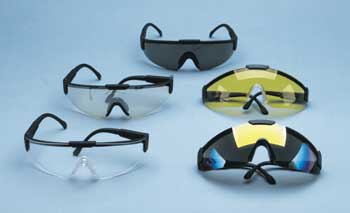
Face Shields
Safety Glasses
Special Safety Glasses or Goggles
Chemical Goggles
Chemical Goggles should be worn when there’s a risk of exposure to toxic or irritant fumes.
Bifocal, Trifocal and Corrective Prescription Glass Lenses
- Protective glasses and face shields that cover corrective prescription lenses are available commercially from various vendors (e.g. Fisher, VWR).
- Prescription safety eyewear must meet the requirements of CSA Standard CAN/CSA-Z94.3-92, Industrial Eye and Face Protectors.
- Bifocal and trifocal glass lenses must not be used if there is danger of impact unless they are worn behind impact-rated goggles or other eye protection acceptable to the Board.
Contact Lenses
Contact lenses can be a hazard and sometimes should not be worn in the lab. Therefore contact lens wearers have three options in the labs:
- Remove the contact lenses before entering the lab and wear safety glasses or safety goggles.
- Replace the contact lenses with prescription glasses
- Wear contact lenses into the lab under a pair of safety goggles but supervisor/lab manager must be informed.
Body Protection
Use appropriate skin, hand, foot or body protection if a worker is exposed to a substance or condition which is likely to puncture, abrade or otherwise adversely affect the skin, or be absorbed through it.
If there is a danger of injury, contamination or infection to a worker’s hands, arms, legs, or torso, the worker must wear properly fitting protective equipment appropriate to the work being done and the hazards involved.
Gloves
Use when there is a risk of: cutting materials, working with extreme temperature, chemical burns, hazardous material skin absorption.
Depending on the procedure to be carried out, different types of gloves must be available in the laboratory. The gloves should fit the chemical. Check for appropriate: glove material, permeation rating, and breakthrough time. Permeation rating describes the ability of a protective garment to resist permeation. Breakthrough time is the elapsed time between initial contact of the chemical with the glove surface and the detection of the chemical on the inside of the glove.
Gloves are made from a variety of materials which vary in their permeability and wear-resistance. Disposable gloves are made of PVC, latex, nitrile, and combinations of the aforementioned. These gloves are for general use and have low abrasion resistance. More resistant, impermeable, reusable gloves are made from butyl rubber, nitrile, or neoprene. For more information on gloves resistance see the Ansell Chemical Resistance Guide.
Asbestos gloves should not be used! If any are found, they should be replaced.
Here are characteristics and uses of some common types of gloves:
- Surgical gloves (e.g. latex, rubber, vinyl) range from 8 to 10 mils in thickness, offering the good tactile sensitivity and dexterity required for many procedures. However, they offer very little, if any, protection against needlestick injuries, sharps, or animal bites. This has resulted in laboratory exposures and infections caused by the false sense of security associated with the wearing of surgical gloves. Latex gloves also cause sensitization.
- Nitrile gloves are highly resistant, have less pinholes than latex gloves and give maximum protection from liquid chemicals. They are hypoallergenic.
- Thin Nitrile gloves are good for general use.
- Heavy-duty Nitrile gloves are for a heavy volume of chemicals; also for spill clean-up.
- Rubber gloves have good chemical resistance, low abrasion resistance.
- Neoprene gloves are almost impermeable to regular solvents, fairly abrasion resistant.
- Kevlar gloves are cut resistant for handling glassware.
- Heat-Resistant Multi-Composite gloves should be used to protect high or low temperatures or special procedures.
DO NOT WEAR GLOVES OUTSIDE THE LAB!
This includes: hallways, elevators, lunch rooms, meeting rooms, and bathrooms.
Lab Coats
Lab coats should be made of strong fabric and must be able to be removed quickly in case of accident. They must be long enough to protect the legs.
Location of clean lab coats at HLI: Room M115 (at the back of the Gourlay seminar room). They are no name except for PI’s. Dispose of dirty lab coats in the hampers provided.
Lab coats exposed to harmful chemicals, biohazardous and radioactive materials should not be worn in public areas.
Yellow Gowns
Yellow gowns should be worn in containment areas like the tissue culture rooms, virus rooms, etc. They have long sleeves with elastic cuffs that protect the wrists and a solid-front with ties at the back to protect the worker’s front body from spills and splashes while working in the biosafety cabinet. Yellow gowns must be removed before leaving the containment rooms. Dispose of dirty yellow gowns in the hampers provided.
Footwear
Workers’ footwear must be of a design, construction, and material appropriate to the protection required. To determine appropriate protection the following factors must be considered: slipping, uneven terrain, abrasion, ankle protection and foot support, crushing potential, temperature extremes, corrosive substances, puncture hazards, electrical shock and any other recognizable hazard. If a determination has been made that safety protective footwear is required to have toe protection, metatarsal protection, puncture resistant soles, dielectric protection or any combination of these, the footwear must meet standards requirements (refer to Occupational Health and Safety regulations for details).
Basic Footwear Requirements For Wet Laboratory Work:
- Substantial shoes must be worn and should cover the entire foot.
- Open-toed shoes and sandals must not be worn in the laboratory.
- Safety shoes or foot guards may be required under certain circumstances (e.g., when moving
compressed gas cylinders – foot guards are available in cylinder storage area). - When cleaning up floor spills wear plastic foot covers available on all spill carts.
Respiratory Protection
Respiratory protection is required when toxic chemicals are used outside the fume hood and there is a potential to exceed allowable exposure limits.
Face Masks
Single-use paper “dust” masks are not classified as true respirators. They do not offer adequate respiratory protection in infected animal rooms or other areas where infectious aerosols may be present because one cannot be ensured of an adequate fit. They may be worn in “clean” animal rooms to reduce possible irritation from allergens such as fur and dander and to help keep hands away from the mouth and nose. Also, they are acceptable for use during necropsies and other procedures on noninfectious animals to help maintain a sterile surgical field. When used for these purposes, the appropriate size must always be worn to ensure an optimal fit for maximum effectiveness.
Respirators
Use of respirators should be considered to control exposure only after engineering and administrative controls have been considered. These types of controls include ventilation (e.g. fume hoods), enclosing the process, substitution with less hazardous products, rescheduling of work procedures, etc.
Users are responsible for:
- Obtaining proper certification for respirator use from HSE or the Safety Coordinator.
- Using the respirator in accordance with training instructions
- Being properly fit-tested for a respirator
- Cleaning, disinfecting, and storing the respirator
- Reporting any respirator malfunction to their supervisor
Air purifying respirators can not be used:
- In a very contaminated environment (when the level of contaminant is greater than the allowable level multiply by the respirator protection factor).
- In Immediately Dangerous to Life and Health (IDLH) conditions. The IDLH concentration represents an estimate of the maximum concentration of a substance in air from which healthy workers can escape without loss of life or irreversible health effects under conditions of a maximum 30 minute exposure time. The US National Institute for Occupational Safety and Health (NIOSH) has quantified exposures to approximately 400 toxic chemicals which could be IDLH.
- When the contaminant has poor warning properties.
Air purifying respirator cartridges are available for use with half-mask and full-face respirators. Select the appropriate cartridge according to the chart below. Consult with HSE or the Safety Coordinator for situations not listed. Always ensure that the cartridges used are appropriate for the types of hazardous vapour present.
Cartridge selection chart for air purifying respirators
| Cartridge Type | Colour | Examples of Uses |
|---|---|---|
| Organic vapor and acid gas | Yellow | Rooftop entry/lab procedures/spills |
| Organic vapor only | Black | Solvents/Paints |
| Dusts, particulate, and aerosols | Purple | Toxic dusts/infectious aerosols/asbestos welding fumes |
| Ammonia/amines | Green | Ammonia Spill |
| Acid Gas | Grey | Acid gases/chlorine/sulfur dioxide |
Instructions for the USE of Respirators:
Personnel must be trained, fit tested and certified prior to respirator use.
When fitting a new respirator, try on several brands and sizes. Different brands will fit slightly differently on your face. Respirator manufacturers usually have small, medium, and large face-pieces available. Adjust the straps so that the respirator fits tightly, but does not dig into your face or leave red marks on your skin. The respirator should feel snug, yet comfortable.
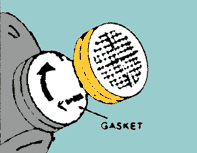
1. Remove respirator, cartridges, and filters from plastic bags. Check to see that gasket is in cartridge holder before screwing in cartridges. Insert filter into retainer caps and snap onto cartridge holder or cartridges.

2. The cartridge holders are keyed to assure their correct positioning and maintain the proper balance of the device. Make sure they are properly positioned and seated.
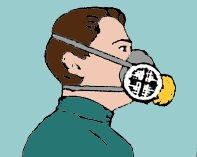
3. Place respirator on face with narrow end over nose and bottom under chin. First attach top headband around crown of head and then bottom around neck. Adjust headbands until a tight but comfortable fit is obtained.
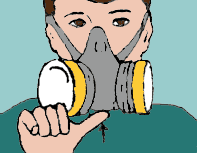
4. Test for tightness: Place the palm of the hand or thumb over the valve guard and press lightly. Exhale to cause a slight pressure inside face piece. If no air escapes, respirator is properly fitted. If air escapes, readjust respirator and test again. There are two simple checks to test the seal. These are called the positive and negative pressure fit-checks. These tests must be done every time the respirator is put on.
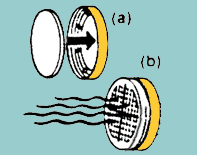
5. Filters (a) Replace when breathing becomes difficult, Insert new filters into retainer cap and replace cap. Generally the filter discs should be changed after eight hours of dusty exposure. (b) Chemical cartridges should be replaced when the senses detect any abnormal condition, assuming that levels of detection by the senses do not constitute a health hazard.
- Maintenance: The respirator face piece should be cleaned daily to prevent skin irritation and for general sanitary purposes. First remove filters and cartridges. Then the face piece may be washed with a hand brush using a good detergent in warm water, rinsing, and air drying in a clean place. Some compounds considered to be suitable for disinfecting are:
- a hypochlorite solution (50 parts per million of chlorine; immersion time: 2 minutes)
- an aqueous solution of iodine (50 ppm iodine; immersion time: 2 minutes)
- a quaternary ammonium solution (200 ppm quaternary ammonium compounds in water with less than 500 ppm total hardness).
Rinse in clean warm water and air dry. Inspect respirator daily for worn or faulty parts and replace these at once. Proper parts supplied by the manufacturer must be used.
- For your protection, the dust filters and chemical cartridges must be assembled tightly, and changed frequently, according to exposure.
- Keep respirator clean when not in use. Store in clean plastic bag or container.
Negative Pressure Fit-Check
- Put the respirator on and tighten the straps until it feels tight but comfortable.
- Close off the cartridges by covering them gently with the palm of hands, plastic bags, or gloves.
- Breathe in slightly to create a vacuum.
- Hold for 10 seconds.
- If you have a good seal, the face piece should collapse slightly against your face and stay collapsed. No air should leak into the face piece past the sides, top, or bottom.
- If the face piece doesn’t collapse and stay collapsed, there is an air leak. Check the exhalation valves and try repositioning the respirator on your face and adjusting the head straps. Try the negative pressure check again. If you cannot get a seal after a few attempts, try on another size, make, or model of respirator, and repeat the check until you find a respirator that will pass.
Positive Pressure Fit-Check
- With the respirator on comfortably, close off the exhaust valve opening by covering it with the palm of the hand.
- Breathe out slightly to force air into the face piece
- Hold for 10 seconds.
- If you have a good seal, the face piece should bulge out and stay out.
- If the air does leak out, check the inhalation valves, readjust the respirator and try the check again. Try on another size, make or model if you fail to pass the positive pressure fit-check.
